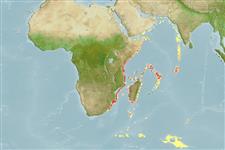>
Myctophiformes (Lanternfishes) >
Myctophidae (Lanternfishes) > Diaphinae
Etymology: Diaphus: Greek, dis, dia = through + Greek, physa, phyo = to beget, to have as offspring (Ref. 45335); mascarensis: Named after the banks of the Mascarene Ridge, its place of capture..
Environment: milieu / climate zone / depth range / distribution range
Ecologie
marien bathydemersaal; diepte 237 - 800 m (Ref. 41745). Deep-water
Western Indian Ocean: banks of Saya de Malha and from the Nazaré Bank.
Grootte / Gewicht / Leeftijd
Maturity: Lm ? range ? - ? cm
Max length : 14.4 cm SL mannelijk / geslacht onbekend; (Ref. 41745)
Taken in bottom trawls, probably benthopelagic (Ref. 41745).
Levenscyclus en paargedrag
Maturiteit | Voortplanting | Paaien | Eieren | Fecunditeit | Larven
Bekker, V.E. and Y.N. Shcherbachev, 1990. Bathypelagic species of the families Neoscopelidae and Myctophidae from the Indian Ocean, with a description of a new species of Diaphus. J. Ichthyol. 30(7):122-134. (Ref. 41745)
Status op de Rode Lijst van het IUCN (Ref. 130435)
Gevaar voor de mens
Harmless
Gebruik door de mens
Meer informatie
Lokale namenSynoniemenMetabolismePredatorenEcotoxicologieVoortplantingMaturiteitPaaienPaaiaggregatiesFecunditeitEierenOntwikkeling van de eieren
Leeftijd/Grootte
Groei
Lengte-gewicht
Lengte-lengte
Lengtefrequenties
Morfometrie
Morfologie
Larven
Larvale populatiedynamiek
Rekrutering
Abundantie
BRUVS
ReferentiesAquacultuurAquacultuurprofielKweeklijnenGeneticaElectrophoresesErfelijkheidZiektesVerwerkingNutrientsMassaconversie
Tools
Speciale rapporten
Download XML
Internetbronnen
Estimates based on models
Preferred temperature (Ref.
123201): 9.7 - 13.2, mean 11.4 °C (based on 37 cells).
Fylogenetische diversiteitsindex (Ref.
82804): PD
50 = 0.5000 [Uniqueness, from 0.5 = low to 2.0 = high].
Bayesian length-weight: a=0.01148 (0.00367 - 0.03596), b=2.99 (2.74 - 3.24), in cm total length, based on LWR estimates for this (Sub)family-body shape (Ref.
93245).
Trofisch niveau (Ref.
69278): 3.2 ±0.3 se; based on size and trophs of closest relatives
Weerstandsvermogen (Ref.
120179): Gemiddeld, minimale populatieverdubbelingstijd 1,4-4,4 jaar (Preliminary K or Fecundity.).
Fishing Vulnerability (Ref.
59153): Low vulnerability (10 of 100).
